From gleaming Buddhist temples to buzzing night markets, and from its delicious food to its gorgeous coastline, it’s easy to see why Thailand is ever so popular as a backpacking destination.
In fact, Thailand is often seen as a rite of passage among backpackers. Ask any globetrotter if they’ve ever been and chances are their fond memories and stories of backpacking Thailand come bursting right out like confetti.
Now, it’s your turn to jump in!
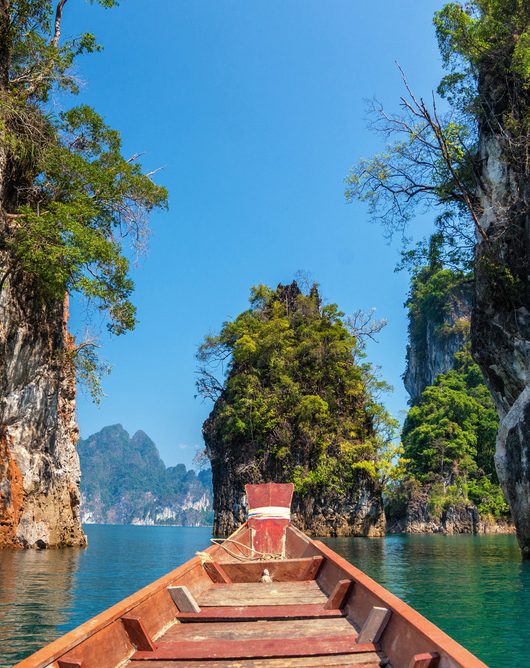
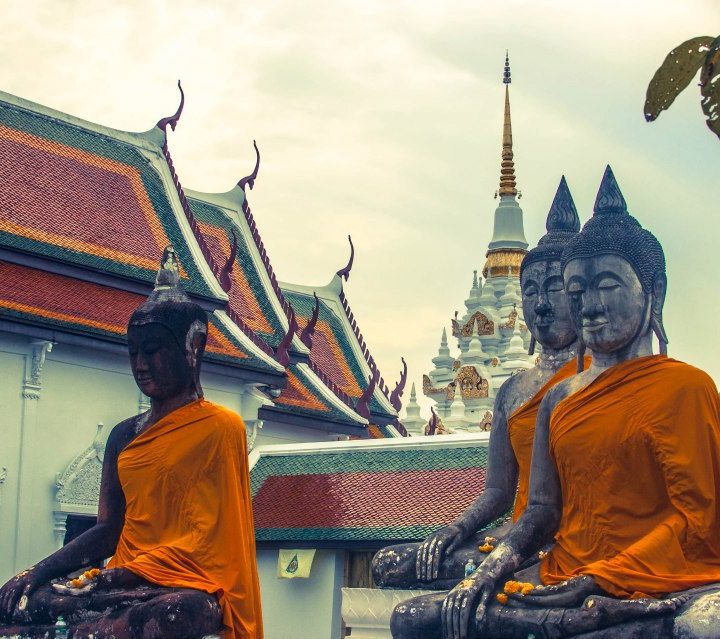
I’ve been to Thailand many times now and always like to come back for more. But I also still remember what it felt like the first time I landed in Bangkok, excited to be in this exotic other world, but also nervous to be at the start of a new adventure.
Luckily, backpacking Thailand is pretty easy if you come prepared. Read on for my top tips for backpacking Thailand.
Plan your Thailand backpacking trip
Backpacker scene in Thailand
The one thing that makes Thailand so easy and fun is the backpacking scene. You’ll find lively traveler hubs all over the country.
There is usually about a 50/50 mix between travelers who are going around Thailand and those at the start of a longer trip through Southeast Asia. This is because Thailand is often the logical first country to go to if you’re backpacking the region.
Thailand is popular with many younger travelers but you’ll truly meet people of any age and type — from party animals to cultural travelers, from hippies to luxury-lovers, and from social butterflies to introverts.
So don’t worry, whatever vibe you’re looking for, you can probably find it.
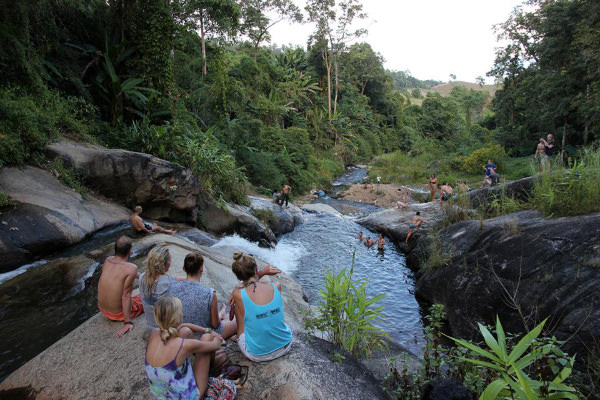
The key to tapping into the travel scene is to stay in hostels as much as you can. Alternatively, stay in local guesthouses or budget-friendly jungle lodges, as these often attract more of a backpacking crowd.
Cheap hostels can be found pretty much anywhere in Thailand. Some of these are party hostels, others are more social backpacker hostels, so you just have to pick the ones with an atmosphere you like. You can usually tell from the descriptions what audience they’re targeting.
There is definitely a big party scene in Thailand, especially in the south around some of the islands. Koh Phi Phi is notorious for it, as are parts of Koh Phangan. The backpacker street of Khao San Road in Bangkok is another place that seems to never sleep. The party scene in Thailand can be a lot of fun, but it’s also easily avoided if it’s not your thing.
Generally speaking, the northern parts of Thailand are more ‘adventure and culture’ and the southern parts more ‘beach and fun’, though there are many exceptions to this rule of thumb.
Thailand backpacking routes
Even though there are more places to see in Thailand than you could possibly cover in one trip, there is a pretty well-established backpacking route in Thailand.
My number one tip is to visit the center and north before you visit the south.
The north is more mountainous and travelling there is more focused on the culture and nature. You can have a great time there sampling the food, going on hill tribe treks, or just chilling in cheap Chiang Mai or some of the smaller mountain towns.
The south is more beach-focused with a mix of backpackers and people who are there just on a beach or resort holiday. I think it’s fun to keep the beach in your itinerary last after you’ve done a bunch of exploring first. Otherwise, you might just get stuck at the beach the whole time!
But why stop at Thailand?
This country is a perfect gateway into Southeast Asia, bordering Laos, Cambodia, Myanmar, and Malaysia. If you’re considering a bigger trip in the region, don’t miss my Southeast Asia itinerary tips.
Finding great places to stay
Having a great trip in Thailand is not just about where you’re going, but also where you’re staying. Backpacking Thailand is really fun and social, but this also depends hugely on the hostels you choose.
On my first visit to Thailand as a newbie traveler, I booked a normal hotel in Bangkok for the first couple of nights. I thought this would be a nice way to get acclimatized, get through my jet lag, and have a bit of extra comfort as I settled in.
Well, it sucked.
Staying in a hotel was dreadfully boring as all the other guests were not into socializing at all.
My accommodation was also in a dull commercial district, giving me a poor first impression of Bangkok. It kinda put a damper on my first few days in Thailand.
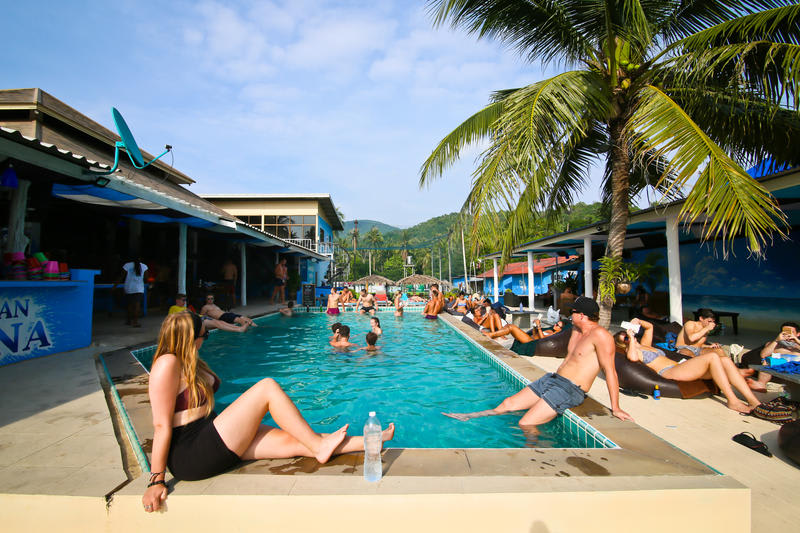
But soon I ended up in Chiang Mai and stayed in an amazing backpacker hostel. I had an absolute blast as there were always other travelers to do trips with and I got so many tips for great places to check out. Every morning at the breakfast table I made plans with other backpackers and we formed new groups for activities every day.
Recommended hostels in Bangkok
$ Hostel
Suneta Hostel Khaosan
I love this hostel! It's not too big and great for meeting people. Just a block or two from Khaosan
$$ Hostel
The Yard Hostel
Chilled out garden and in a local neighborhood. It's a bit far from the center, but my fave!
As you can tell, I think the hostels are 100% key to the Thailand backpacking experience. To set you off on the right track, I’ve listed 5 amazing hostels in Bangkok that will drop you right into the traveler scene.
The main website to find hostels is Hostelworld. Although it’s easy to improve in Thailand and make up your trip as you go, one great thing about Hostelworld is that you can make bookings there and still cancel them without any fees up to 24 hours before arrival. It’s worth booking your favorite hostels just to make sure you’ll have a bed. Since you can still cancel, it’s a good way of planning ahead, even if your plans can still change.
Staying in hostels is fun, but sometimes it’s nicer to be in a guesthouse. I loved staying in bamboo huts in jungle villages in northern Thailand, or renting a cheap beach bungalow on the islands. If you meet other backpackers (as you inevitably will) you can team up to share the costs of a room. You can often find great deals for guesthouses and locals hotels on Booking.com.
Is backpacking Thailand cheap?
There is often some confusion about the cost of travel in Thailand. This is probably because it does have its share of luxury resort tourism, which gets promoted a lot in magazines and through Instagram influencers.
However, you don’t need to splash your cash to have fun in Thailand. In fact, far from it! Thailand is an amazing budget destination, especially if you know where to go.
You can travel in Thailand for about $30 a day, roughly speaking — at least, if you stay in hostels, eat mostly the local food, and don’t pay for expensive tours. The center and north of Thailand are by far the cheapest.
In the northern city of Chiang Mai, a dorm bed goes for as little as $6 a night. Decent rooms can be found for $12 (e.g. think bamboo bungalows).
The north of Thailand is truly one of the best value destinations in the world. Backpackers and digital nomads constantly rave about how cheap it is. Rising levels of development in Thailand actually haven’t changed this one bit.
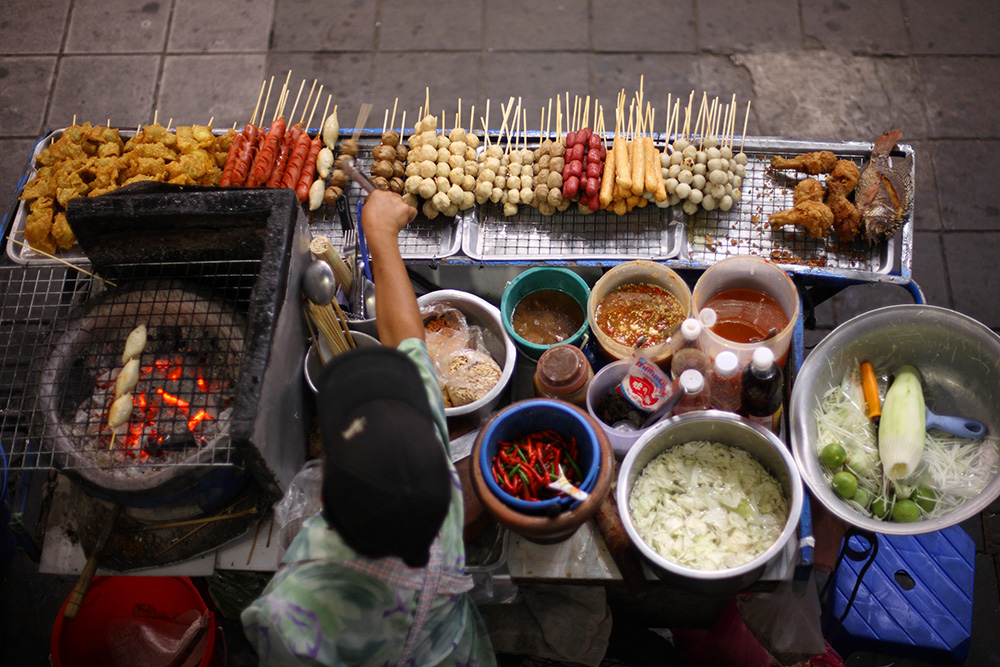
The south of Thailand around the coast can be pretty pricey, though!
The island of Koh Phi Phi is so popular that basic twin rooms cost about $50–80 and even many dorm beds exceed $20/night. On Koh Phangan, some dorms that are near the Full Moon beach can cost as much as $40/night. If you’re only visiting the most popular Thai beaches and islands, know that your daily budget will go up a lot.
So, it depends where you go.
But in general, Thailand is a cheap country. For example, you can get a filling meal from a street vendor, like a Pad Thai, for around 40 THB ($1.30). A large bottle of beer from a mini-mart costs 50 THB ($1.60). So, you can see how Thailand can be very easy on the wallet.
Is Thailand safe?
This is a question I still get a lot, which is understandable as you may not know the situation in a country far away. However, Thailand is definitely very safe, especially as far as violent crime or any serious stuff goes. Seriously, don’t sweat it.
But… traveling in Thailand is not without other possible safety issues. I can speak a bit from experience here.
The most common problems in Thailand have more to do with unsafe behavior than with crime. Luckily, this is something you can control.
Insurance for your Thailand trip
Travel Advice
Travel insurance will cover you for theft, medical expenses, cancellation, and more. Heymondo offers great coverage, no excess or deductibles, and an app with 24/7 assistance & doctor chat.
5% Off With Indie Traveller
Be especially careful driving motorbikes or scooters. Many backpackers do this for the first time in Thailand because bike rentals often don’t even check your license or ability to drive. But if you happen to slide or crash, the asphalt will just rip your skin off like a potato peeler — or worse. Scooter accidents are sadly way too common in Thailand so this is a genuine safety issue to consider.
So yeah, forget about axe murderers but be mindful of traffic safety! Having said that, renting a scooter is a super fun way to explore and lets you go sightseeing at your own pace. Driving past the rice fields and jungle mountains is such a great feeling.
One of the wonderful things about Thailand is that it’s highly safe in a societal sense. So long as you travel responsibly, you can pretty much go anywhere and just go with the flow, even if you’re traveling alone.
Of course, petty theft can still happen as anywhere else, so be sure to keep your valuables locked away in a secure locker at your hostel and just use your common sense in all other situations.
I recommend getting some travel insurance before you go as this will cover you financially and provides support in the case of theft, medical emergency, or other situations.
Backpacking solo in Thailand
Thailand is a perfect solo travel country for two reasons:
- The travel logistics are pretty easy to figure out, so you’ll have less stress if you’re by yourself
- There are so many backpackers in Thailand that you’ll rarely have to be alone
If you’ve never traveled solo before, then Thailand is one of the best countries to try it out. You may still conclude it’s not for you, but chances are it will open your eyes to just how fun it can be to travel by yourself.
You can certainly pick some forgotten beach on a Thai island and live a Robinson Crusoe life for a while, but if you travel to any of the known tourist destinations you’re destined to meet other (solo) travelers everywhere.
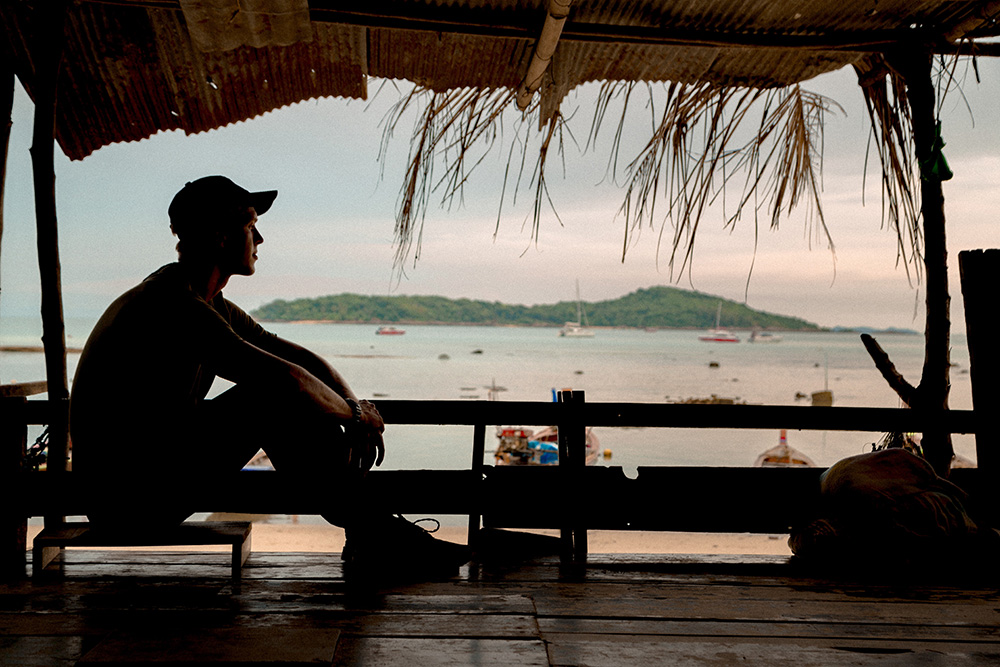
My experience backpacking solo in Thailand is that it can, in fact, get a bit much sometimes. It’s possible to get a bit mentally exhausted from how many people you meet. If you get to that point, you always have the option to just do something by yourself for a day or two.
If you’re not already meeting people spontaneously, another great way is to sign up for shared activities, like walking tours, snorkeling trips, hiking, or adventure sports.
Language barriers
First, some good news: you don’t need to learn Thai to travel in Thailand.
It does help to know a few phrases in the local language, such as hello, goodbye, and thank you. People will always appreciate your attempt to learn such basics. But you can get by in Thailand just using English for the most part.
It’s not common for the average Thai person to know English, but those who work in the tourism or service industry will usually know enough to at least communicate with you on a basic level. Important signs are usually also displayed in English, so you don’t have to worry too much.
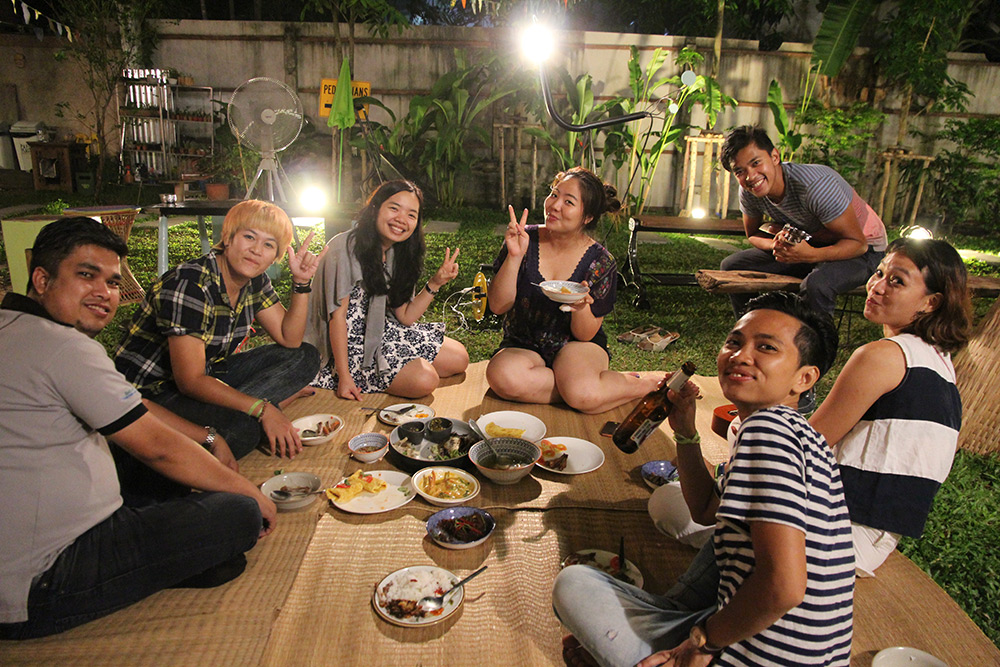
Every now and then you do face a language barrier, but dealing with this is just part of the fun of traveling.
Cultural etiquette
Thai people are widely known as being extremely welcoming and laidback. It’s no coincidence Thailand is known as “the land of a thousand smiles”.
But as with any country, there are specific unwritten rules of etiquette that are good to know about when engaging the Thai people.
In Thailand the head is deemed to be the highest and most respected part of the body, therefore it is very rude to touch someone’s head, with the exception of very small children. You also shouldn’t point at anyone with your foot or step over someone. Remove your shoes or flip-flops before entering someone’s house (this often also applies to shops).
The “Wai” (raising your hand’s palms together in salutation) and uttering the words “sawadee kup/ka” (kup for men and ka for women) is very important in Thailand. When you encounter someone older than you, “wai” first. Someone younger will “wai” you first, then you return the gesture. If you’re not sure, then “wai” as soon as you make eye contact.
Don’t worry, most foreigners don’t know how this works, and Thai people will not be offended if you just say hi. But they will certainly appreciate it if you follow the Thai ways.
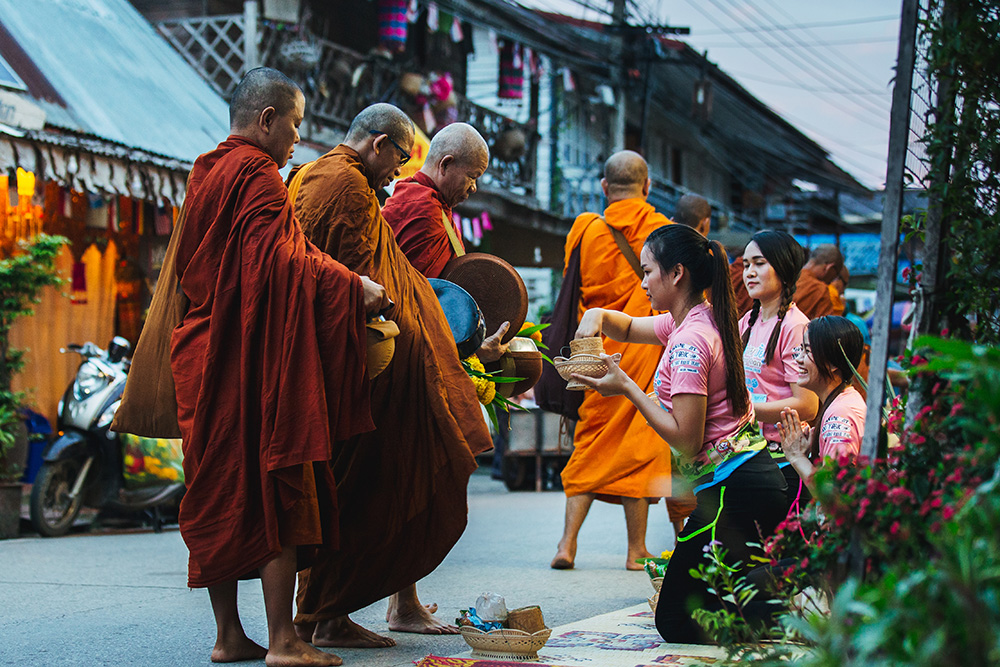
One essential thing to keep in mind is that temples are sacred spaces. So, don’t go frolicking around a temple in just your hotpants or mankini!
Temples that are often visited by tourists typically provide sarongs or cloths for you to wear while inside. Use them to cover up in the ways that are indicated.
If you sit before a monk then always sit lower than them and make sure your feet are either under you or pointing away from them. This is also true when you are seated before a Buddha image or statue.
Finally, never insult the king of Thailand. He’s the super most important dude and any perceived insult to him is a crime. (There was once a story of a backpacker pissing in an alley and accidentally doing so all over a poster of the King — and so he ended up in jail. Just FYI.)
Getting around in Thailand
Moving from A to B is not so difficult in Thailand, especially if you’re moving between known tourist destinations.
You can usually book your bus, train, or minivan trips at the reception desk of your accommodation, but there are also tons of little travel agencies everywhere that can help you out.
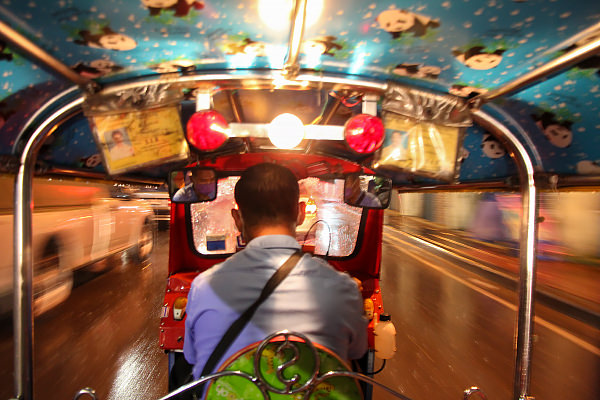
Whatever connection you need, they can usually figure it out for you. There are often very easy combination tickets that include any transfers you might need. Buses and minivans are cheap and convenient and can you can easily book them from hostels or local agencies.
If you need to book online, try 12go.asia, which has the widest coverage in Southeast Asia for buses, trains, ferries, and transfers.
You can hop around Thailand easily using budget flights, but I think the trains are more fun, better for the environment, and often cheaper. They’re a good option for traveling from Bangkok to Chiang Mai in the north (these trains also go overnight) or from Bangkok and Surat Thani in the south.
Traveling by train has a certain charm and will make you feel like you’re on a proper journey, so I always like to recommend this way of getting around.
When to go to Thailand
Broadly speaking, the rainiest months are from September to October. That goes for the country as a whole, though in the south, the monsoon has a different length on each coast:
- West coast: May to October
- East coast: September to December
If you are in Thailand for a short time and need the weather to be ‘perfect,’ you may wish to go in the tourist high season of December to February.
Outside of these months, you’ll have other advantages such as lower costs, more available accommodation, and fewer crowds. Even in rainy reason, it won’t rain all the time; tropical rain showers are often intense but short-lived, and you can dry up pretty quickly. The forests and rice fields look greener and lusher during this time of year as well.
If you’re traveling through the Southeast Asia region, then keep in mind the monsoon in other countries can be the opposite of Thailand. For instance, Indonesia has its dry season from May to September, which is when it’s rainy season in most of Thailand, so you may wish to consider the order in which you visit the countries.
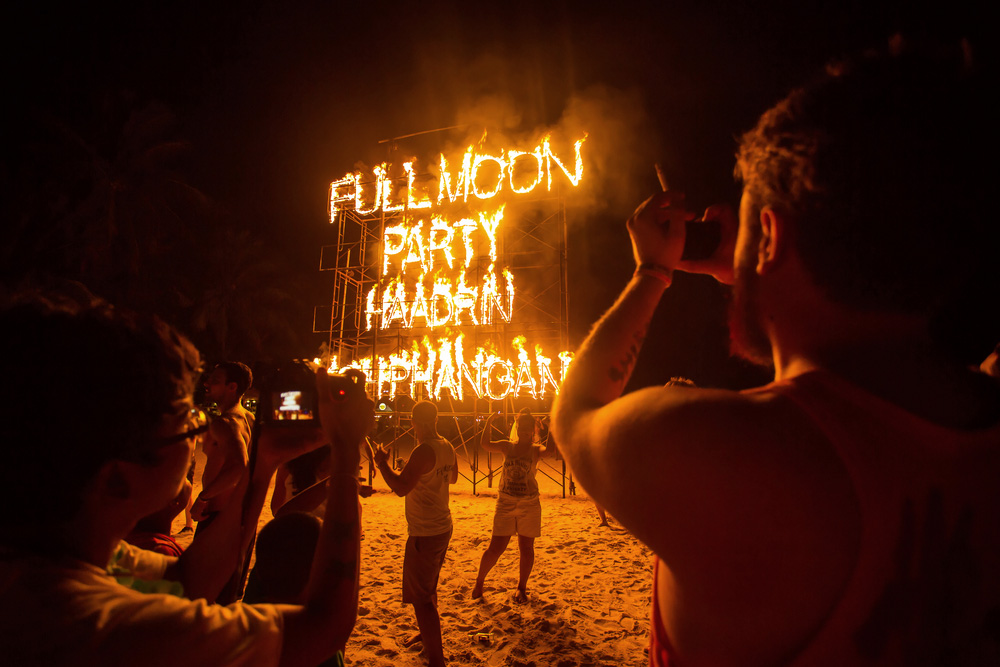
Unique experiences in Thailand
Finally, let me mention some of the great things you can do while backpacking in Thailand.
- Get lost in Bangkok’s Chinatown. I love exploring its maze of markets and narrow alleys. You’ll see fishmongers chopping fish, welders fixing equipment, and exotic foodstuffs for sale—all amid a sea of Thai and Chinese neon signage. You can read more about the best areas of Bangkok to explore.
- See the ruined capital of Sukhothai. Once the heart of the Siamese empire, these are the largest ancient ruins in Thailand. It’s a big area so it doesn’t feel as crowded as some of the sites in Bangkok.
- Chill in the northern city of Chiang Mai. Lots of great food markets here, and the cost of accommodation is crazy cheap.
- Go hill tribe trekking in the north, through lush jungles and visiting some of the minority villages near the border.
- Hang out in the riverside hippie town of Pai, quite touristy but in a really fun way.
- Go island-hopping on the southern coast. The southwest of Thailand, in particular, has tons of smaller islands that you can get to more easily.
- Go rock climbing or deep-water soloing in Krabi, the coastal region with loads of big craggy cliffs. There are guided sessions for beginners and advanced. Thailand is a great destination for cheap and safe adventure activities.
- Cover yourself with glow-in-the-dark neon paint and party all night long at the Full Moon Party, held once a month on the island of Koh Phangan.
- Go snorkeling or learn how to scuba dive! The island of Koh Tao is one of the best places to learn scuba diving cheaply, but there are great reefs all over the Thai coast
Some links may be affiliate links, meaning I may earn commission from products or services I recommend. For more, see site policies.
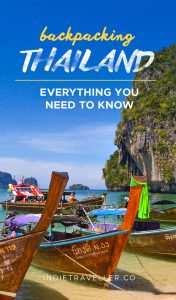
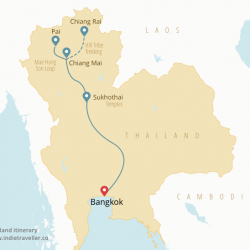


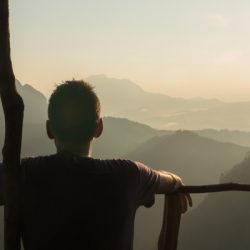




What a great guide! Thailand is one of the best and fun budget destinations I’ve ever visited. Love the vibe, food and people!
Hi Marek,
I’m planning on visiting Thailand as the 1st stop in my Gap year, I was wondering if you had any advice about where you recommend I should take a look at, I am slightly cautious as I will be a woman travelling alone so I’m not sure what you think is ok to do alone, or if it would be a good idea to book some guided tours or anything? Any advice you or anyone else reading this would be 100% welcome 🙂
Thanks,
Tala
Hey Tala! Thailand is really great to travel by yourself (male or female) as it’s safe and relatively easy. If it puts your mind at ease you could maybe book a short organized tour at the start of your trip, just to get used to things. But I don’t recommend booking a big organized tour for your whole trip, especially not if you’re going on a gap year. You’ll save a lot of money doing it yourself and it’s easy to meet people (including other solo female travelers) if you stay in hostels.
I remember way back when I first went solo to Thailand it was a bit scary for the first few days, just because everything was still unfamiliar, but then I got the hang of it and was loving it. Bangkok is a bit chaotic, but I felt much happier when I got to Chiang Mai, which is more relaxed and a lot of fun. You might benefit a lot from my book which goes into this exact question in a lot more detail 🙂
Thank you !! That’s incredibly helpful!
Hey Marek
My husband and I are taking our 2 boys, 15 and 17 Mar 2023 for 2 weeks. We will land in Bangkok and go from there. I know 2 weeks isn’t a long period of time. What places would you recommend us to visit? Also, I am a bit nervous about once we get to each place how we would get around that town. Are there bike and motorcycles every where ?
I’d suggest maybe 1 week in Chiang Mai and around, and 1 week on the coast such as in Krabi or Koh Lanta. Could also consider Kanchanaburi near Bangkok.
There are definitely loads of transportation options everywhere. With a family it’s probably easiest to get a cheap local taxi. Small motorbikes can also be rented virtually anywhere and any places where tourists go will have small travel agencies that can tour you around the local sights. So don’t worry about this 🙂
Do you know if you can apply for an extension to the 30 day visa-exemption period at a Thai immigration centre? As an Aussie I’ll be allowed to enter the country with the exemption, but I am unsure whether I will stay longer than 30 days or not (I begin backpacking there from March). Cheers!
Hey Kieren. No, a visa-on-arrival can only be extended at immigration for another 7 days, if my memory serves correctly. Alternatively, you could cross the border somewhere (e.g. into Laos or Vietnam) and come straight back, giving you another 15 days in Thailand. Or you can get out of the country and fly back to Thailand, giving you another 30-day VOA.
If you just want to stay more than 30 days in Thailand without any such maneuvering, you might want to get a proper advance visa that can be extended.
How to book the overnight train?
You can book that easily on this site 🙂
You can use this to prebook your tickets. It is set to get to koh samui but you can change the search as you want…
The overnight train is great to option to save day time and a hotel night 😉 https://kohplanner.com/how-to-get-to-koh-samui
I can’t wait to visit Thailand! Though many tourists visit, it just seems as such a beautiful country!:) Im visiting in January but am not quite sure what islands to focus on.I would like to try and get away from the “backpacking trail” if thats even possible.. Do you have any suggestions? Great post 🙂
It’s a big country so definitely possible. The smaller islands on the Koh Chang archipelago may be a good bet 🙂
Hi Marek, I love your website, you’re very helpful!
Me and my girlfriend would like to pass one week in a place where we could be in complete contact with nature, whether it’s forests, volcanoes, hills or beaches (we wouldn’t dislike staying close to the sea but not just pass days sunbathing, you know).
We live in Shanghai, so let’s say that for convenience we would consider only south Asia.
We haven’t got experience as backpackers, also if we traveled a lot, mainly in Europe and Magreb.
What would you suggest as a refreshing and breathtaking travel/adventure?
Reading your blog we were considering Tahiland (so hard to choose from your guide), Palawan, Bali, Jeju island… But it’s so hard to choose, we would love to have your opinion.
Thanks heaps!!!
Hard to say as Southeast Asia is so big! I like Northern Thailand for being in/around nature. Northwest Bali is good for that too (avoid the more built-up south). Palawan is awesome although El Nido and the lagoons are very busy these days. In the Philippines the Cebu/Bohol area can be awesome too… there’s fun hiking opportunities (search for osmena peak or casino peak), canyoning, etc.
Just free-associating here for a bit 🙂 Hope it helps
Dear Marek,
I am a Czech girl from Prague who will travel alone. I will arrive in Bangkok on October 27th and leave back from Bangkok on November 24. So I have a month. I came up with the the following itinerary trying to get the most out of my Thailand/Vietnam experience while being able to enjoy it and without feeling rushed.
I enjoy beautiful nature,interesting markets and people, fish markets, anything exotic, adventure, beautiful beaches with crystal clear water, places with a great vibe and atmosphere, exotic getaways, great Thai food, vibrant as well as untouched beaches and more.
Itinerary:
1) I will arrive in Bangkok on October 27th and without leaving the airport, immediately take a flight to Chiang Mai.In Chiang Mai (I have not booked that flight yet as I keep my options opened), I will stay for one week to explore all the highlights and must sees in that area leaving Chiang Mai on November 3rd (and might possibly consider to stay until Sunday November 5th to witness that amazing parade of that famous festival on the evening and leaving Chiang Mai on Monday November 6th instead (do not know if that is not too long though)
2) Take a flight from Chiang Mai to Krabi and do the following in 7 to 10 days:
Enjoy Krabi and then I might go to Khao Lak and possibly include Khao Sok park as well (however I read that guided tours there are extremely expensive and without them, it is not worth it and difficult to go there…is this true?). From Khao Lak, I am thinking about taking a 3 day snorkeling liveaboard to the Similan Islands (Is this worth it during this time of the year? I am not sure about this and would greatly appreciate other options and ideas) After Khao Lak, I would go to Koh Yao Yai. There is a ferry between Koh Yao Yai, Koh Yao Noi (a nearby, smaller, but more populated/developed island), and Phuket island
3) Take a flight to Saigon and do the following in 7 to 10 days:
a) Explore Saigon
b)Relaxing in Nha Trang
c)Explore Hanoi and Halong Bay
4) Take a flight back to Bangkok (maybe spend a day in Bangkok as I have been there before and spend a week there) before taking a flight back home.
Questions to part 1 of itinerary: What are the absolute highlights and must sees in Chiang Mai and the surrounding areas that are just amazing? I mean I have my ideas but I would like to get your ideas and suggestions as I am trying to avoid wasting time through tourist traps where you get there and say to yourself why the hell did I come here? Also, is 10 days too much time staying in Chiang Mai exploring all it and the surrounding areas have to offer considering I have 30 days overall?
Questions to part 2 of itinerary: Is 7 to 10 days a good amount of time to explore the south Thai islands as indicated in my itinerary? Again, I am looking for must sees and highlights that significantly add to the overall experience that have that wow effect. Would you add something or leave something out? Any specific advice/suggestions greatly appreciated.
Questions to part 3 of itinerary Vietnam: Is 7 to 10 days a good amount of time to explore Vietnam as indicated in my itinerary? Again, I am looking for must sees and highlights that significantly add to the overall experience that have that wow effect. Would you add something or leave something out?
Any specific advice,suggestions and ideas are greatly appreciated.
Thank you so much for your help.
Klara
PS: Is this a smart itinerary for this time of the year and considering I have a month? I am open to any suggestions, ideas and advice to make the most out of my trip.
Hi Klara! Looks like you already did a lot of research and it sounds like a fine plan in general. Lots of questions here so let me answer a few quickly:
– 10 days in Chiang Mai is quite a bit (given you have a month), but you can consider adding nearby places like Pai and Chiang Rai which only take a few hours to get to. Elephant Sanctuary (look for the ethical ones) near Chiang Mai is fantastic, doing a hill tribe trek is highly recommended as well… you could do an overnight trek given that you have some time.
– Regarding Khao Sok, it depends what you consider expensive. You can find 2 or 3 day tours there for under $100. It’s true you do get a better experience with a tour as it usually includes kayaking on the lake and other activities. Doing it independently is more difficult.
– Nha Trang is not that amazing… it’s got a pretty standard city beach, and you’ll have seen much better in Krabi by then. Maybe it’s worth flying to Da Nang instead and visiting Hoi An or something, then heading up to Hanoi. That will make your route in Vietnam a bit more manageable.
– As far as I know liveaboards are mainly about the scuba diving with snorkeling often added for those who can’t dive… might be a pricey experience for multiple days of snorkeling, though I must admit I’ve not done such a trip (so maybe it’s totally amazing, not 100% sure!). Maybe google around to see if any snorkelers enjoyed it as much as the divers and read some reviews.
Hi marek!
Super Nice blog, i Can really use a lot of it! Im travelling around for 6 month, mostly Thailand.have to go to Cambodia for new visa though, and thought i would go to The northern part of Thailand aftewards. Do you have any advise of how to get there? I would prefer not flyingeniør to much, since i have a lot of time anyways 😉
Best Charlotte
The quickest is a flight from Siem Reap to Chiang Mai. Otherwise take a bus to Bangkok from Cambodia, then an overnight train to Chiang Mai. Rome2Rio.com is a good site to check for this sort of thing. 🙂
Hey Marek, thanks for the info. Next year in April I will make my first solo trip to southeast Asia. After 3 weeks in Bali I want to travel about 10 days to Thailand or Vietnam. Which destination would you choose for that short time? Thanks
Hoi Marcel. Hmm, that’s like choosing between chocolate and ice cream, both are amazing in their own way 😉 I’d probably simply pick the country that sounds the most appealing to you based on reading travel guides, and then pick one part of that country to focus on (e.g. spend a day or two in Bangkok and then either the islands or the north in Thailand, or choose between southern or northern Vietnam).
Hi Marek. I think I have to visit both countries once. As you wrote in your reviews Thailand will be probably the first one to visit for someone who has never been in Asia before. I will definitely buy the expert guide to get the most of my trip. Thanks for your advice man!
Hey Marek,
25 y/o female traveler planning to go to Thailand in about a month’s time from Brisbane, Australia. Aussie has been my first time out of the USA and I’m just a little bit nervous about transportation and getting to and from places effectively. I’m only going to be able to go for about a week…I was wondering if you have any links or guides about transportation in Thailand.
I read someone’s comment previously about hostels. A few friends have told me that it’s best to just show up and walk around and find one that you like for a good price before you actually commit to staying in one. Opinion?
Last question…how much money would you recommend for a week stay? I like to party but I’m not really planning on doing any of that because I’m going to be too busy making moves from destination to destination and don’t want to waste my time being hungover or anything. I really just want to see as many temples as I can and then obviously bake on the beach, and take a few souvenirs back for my family. I read one post that asked $550 but that one wasn’t answered either.
Thanks so much!
Yes, you can just show up and then ‘shop around’, but I think this technique is better used when travelling long term and not in a hurry. If you’re going for a week I’d advise to pre-book via a site like Hostelworld maybe a day or two in advance. You don’t want to waste time haggling or walking around town for ages looking for accommodation.
Transporation is easily arranged ad hoc and most hostels can help you with this. There are also lots of little agencies around where you can buy bus tickets. For a long or important bus/train journey, you could consider booking online, e.g. http://www.busonlineticket.co.th/ For trains booking at least a day or two in advance is advised.
Around $300 should be plenty for a week – though some travellers will spend less. Hugely dependent on your travel style though.
Looking to travel out of the country for the first time and will be going solo. Im a 23 year old female and some family and friends have their opinions on me traveling solo. Was wondering if you had any thoughts on this? Do you see many young woman traveling solo? And do you feel its just as safe as it is for the men traveling to Thailand? Would love to konw what you think! Thanks for all the great tips on here!
I’m a 23-year-old chica that’s planning on doing some solo traveling in Southeast Asia as well. Though I haven’t been to Thailand before, I have several female friends who have traveled there alone and felt quite safe. Traveling solo in general is amazing and very liberating — I’ve mostly just done it in China and Japan so far but am excited to venture out more. Don’t let the worry of your family and friends keep you from doing what you love. Good luck and have a blast! <3
Hi Marek,
Thanks for this good blog about Thailand. My girlfriend and I are planning to visit Thailand as our friends who already visited recommended us to go there, and it came on a short notice as she got unexpected vacation for few weeks, so we decided to give it a go and to travel this Sunday. As we don’t have much time to investigate the other countries in South East Asia, I wanted to ask, if possible, what country by your opinion is most worth to visit in that region, as we were looking for the cheapest and nicest ones, for example like Philippines, Sri Lanka, Cambodia, Vietnam and Thailand (for which we have close information from our friends). Is it maybe better to go to some of these countries, because of pricing, then to Thailand, as we’re looking for relaxation on nice beaches, good nightlife (for few nights to go out), to enjoy in good foods, and maybe do some cheap cloth and electronics shopping if possible (but this is not our main goal). We would appreciate very much if you could give us some advice where would be best to go in that region concerning prices and named above?
Thank you Marek, or anybody else who could give us good advice here! Hopefully we’ll get your or somebody elses response and good advice.
Thanks once again!
Sasa & Sandra
Hey! I’m going backpacking next summer, flying in and out of Bangkok with a total of 43 days in between. Is that enough time to, comfortably, enjoy Thailand, Myanmar, and Cambodia? We’re really interested in both the Buddhist/Hinduism/Historical sites, such as Angkor Wat, and then the beaches, waterfalls, and mountains as well. We need to start our journey and end our journey in Bangkok, so how do you recommend laying out our path?
Thanks!!
43 days should give you plenty of time to see those countries without rushing too much. Starting from Bangkok I’d probably hit up northern Thailand first (it’s the more cultural part of Thailand and a good place to start), then loop back down, overland it to Cambodia, and then come back to Bangkok. Maybe from there get a cheap flight with Airasia to and from Myanmar to save you some travel time. Then spend the last part of your trip on the Thai beaches in the south (a nice and lazy end to your trip).
A route like this does have you circle back to Bangkok a few times, though it’s a very efficient travel hub and it’s not uncommon for travellers to pass through it a few times when travelling in Southeast Asia. Overlanding between Thailand and Myanmar can still be a bit complicated which is also part of why I’d suggest taking a flight there.
Hope this helps!
How hard it is to get around and get food and accomodation if you can’t speak Thai? Especially in the less touristy places?
In my experience it’s generally not an issue. Many people understand some basic English words, especially ones used for ordering food or finding accommodation. If you are in a really non-touristy or rural place, you might experience a little bit more difficulty. Being patient / friendly, miming things or using a little phrase book you can pretty much always deal with the essentials in some way or another.
Hi Marek, Great tips and information. I am a first time solo traveller planning a month travel to Thailand in about two weeks from today. Would a month be too much or what ? Any tips on how should I be planning my tour.
It’s never too much! A month is actually a great amount of time to spend in Thailand. It’s good to get a rough idea/plan ahead of time, but with a month you have a lot of room to improvise as well. Ask people you meet what they liked most in Thailand and consider going to places by recommendation.
Thanks Marek. Getting into hostel accommodation in Chiang Mai, Kho Tao, can they be booked in a day advance or I should be looking into further ahead of time. Also how are the train bookings ?
Unless there is some special holiday then booking a day in advance is always fine in my experience. Same with trains. Ask for the timetable at your place of accommodation, they’ll probably just tell you to go to the station to buy a ticket, then you wait a bit and off you go.